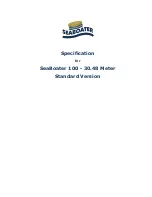
55
Starting
Preparation
Before unloading the watercraft from
the trailer, it can be started for about
10 seconds to verify proper operation.
Attach the safety lanyard to your PFD
and snap the cap to its post before start-
ing the engine.
NOTE:
If you hear more than 2 short
beeps from DESS system, it indicates
a particular condition that should be cor-
rected. Refer to the TROUBLESHOOT-
ING section for the meaning of the cod-
ed signal.
Position shift lever to neutral.
Firmly grip handlebar with your left
hand and place both feet on the foot-
board.
To start engine, depress and hold the
engine start/stop button. Follow pro-
cedure below for engine starting.
If engine fails to start after 10 seconds,
wait a few seconds then repeat proce-
dure.
CAUTION:
Do not hold start/stop but-
ton more than 30 seconds to avoid
starter overheating. A rest period
should be observed between the
cranking cycles to let starter cool
down. Pay attention not to discharge
battery. The engine should be start-
ed only after boarding, when there is
at least 90 cm (3 ft) of water below
the hull. Do not accelerate fast.
Release engine start/stop button im-
mediately after engine is started.
Cold and Warm Engine
Do not depress the throttle lever to
start either a cold or warm engine.
Riding
Slowly
accelerate to reach deeper wa-
ter. Do not apply full throttle until the
engine is warm.
CAUTION:
Avoid watercraft opera-
tion in weeded areas. If unavoidable,
vary watercraft speed.
Rough Water or Poor
Visibility Operation
Avoid operation in these conditions. If
you must do so, proceed with caution
and prudence using minimum speed.
WARNING
Certain components in the engine
compartment may be very hot. Di-
rect contact may result in skin burn.
Do not touch electrical parts or jet
pump area when engine is running.
WARNING
Before starting the engine, the op-
erator and passengers should al-
ways be properly seated.
F01L4OY
F18A02Y
smo2002-003_a.book Page 55 Friday, October 12, 2001 2:04 PM
















































